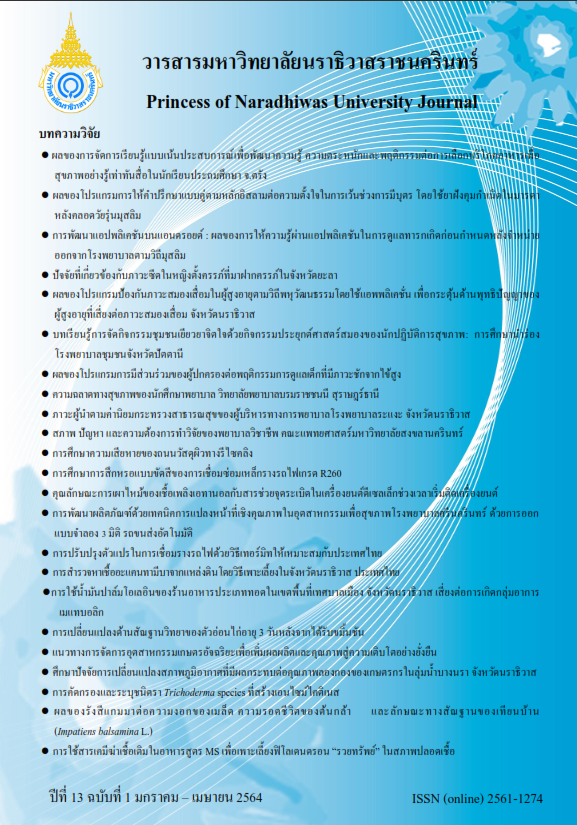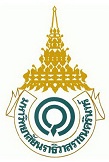Study of Abrasive Wear of Railway Welding Steel Repair, Grade R260
Keywords:
Railway steel, Repaired welding, Shielded metal arc welding, Abrasive wearAbstract
The purpose of this research was to investigate an abrasive wear of the railway steel grade R260 that had not been repaired and one that had been repaired by shielded metal arc welding (SMAW). The covered electrodes used were DIN 8555: E1-UM-350. There were 3 different brands to compare. The chemical composition, microstructure, hardness, wear test, and worn surface of railway steel and repaired weld metals were investigated. The results presented that the railway steel grade R260 without repaired contained pearlite matrix while the repaired weld metal by covered electrodes A, B, and C exhibited grain boundary ferrite and bainitic structure being added. Besides, the hardness values did not follow the wear resistance. The railway steel showed the highest wear resistance, but the lowest hardness. The maximum hardness could be found in the repaired weld metal using covered electrode C compared to other types of the electrode, whereas its wear resistance was minimum. In addition, the worn surface mechanism of the railway steel and the repaired weld metal by covered electrode A was mainly micro cutting. On the other hand, the repaired weld metal by covered electrode B and C resulted in micro ploughing and micro fracture. Therefore, the cover electrode brand A showed the most suitable for repaired welding of railway steel grade R260.
References
ASTM E1245-03. (2003). Standard Practice for Determining the Inclusion or Second-Phase Constituent Content of Metals by Automatic Image Analysis. West Conshohocken: ASTM International.
ASTM E384-17. (2017). Standard Test Method for Microindentation Hardness of Materials. West Conshohocken: ASTM International.
ASTM E407-07. (2007). Standard Practice for Microetching Metals and Alloys. West Conshohocken: ASTM International.
ASTM G65-00. (2000). Standard Test Method for Measuring Abrasion Using the Dry Sand/rubber Wheel Apparatus. West Conshohocken: ASTM International
Bakshi, S. D., Shipway, P. H., & Bhadeshia, H. K. D. H. (2013). Three-body Abrasive Wear of Fine Pearlite, Nanostructured Bainite and Martensite. Wear, 308(1-2), 46-53.
BS EN 15594: 2009. (2009). Railway applications-Track-Restoration of Rails by Electric Arc Welding, London: BSI.
Chang, C.M., Chen, Y.C., & Wu, W. (2010). Microstructural and Abrasive Characteristics of High Carbon Fe-Cr-C Hardfacing Alloy. Tribology International, 43(5-6), 929-934.
Huang, C.A., Liu, Y.W., & Chuang, C.H. (2009). The Hardening Mechanism of a Chromium-carbon Deposit Electroplated from a Trivalent Chromium-based Bath. Thin Solid Films, 517(17), 4902-4904.
Jun, H.K., Seo, J.W., Jeon, I.S., Lee, S.H., & Chang, Y.S. (2016). Fracture and Fatigue Crack Growth Analyses on a Weld-repaired Railway Rail. Engineering Failure Analysis, 59, 478-492.
Lai, Q., Abrahams, R., Yan, W., Qiu, C., Mutton, P., Paradowska, A., et al. (2018). Effects of Preheating and Carbon Dilution on Material Characteristics of Laser-cladded Hypereutectoid Rail Steels. Materials Science and Engineering: A, 712, 548-563.
Leiro, A., Vuorinen, E., Sundin, K.G., Prakash, B., Sourmail, T., Smanio, V., et al. (2013). Wear of Nano-structured Carbide-free Bainitic Steels under Dry Rolling–sliding Conditions. Wear, 298, 42-47.
Roy, T., Lai, Q., Abrahams, R., Mutton, P., Paradowska, A., Soodi, M., et al. (2018). Effect of Deposition Material and Heat Treatment on Wear and Rolling Contact Fatigue of Laser Cladded Rails. Wear, 412, 69-81.
Sato, Y., Matsumoto, A., & Knothe, K. (2002). Review on Rail Corrugation Studies. Wear, 253(1-2), 130-139.
Seo, J.W., Kim, J.C., Kwon, S.J., & Jun, H.K. (2019). Effects of Laser Cladding for Repairing and Improving Wear of Rails. International Journal of Precision Engineering and Manufacturing, 20(7), 1207-1217.
Sergejevs, D., & Tipainis, A. (2016). Assessment of Railway Turnout Element Restoration Using MMA and FCAW Welding. In 15th International Scientific Conference Engineering for Rural Development Proceedings, Jelgava, 25, 606-611.
Shibe, V., & Chawla, V. (2018). Characterization of Fe–C–Cr Based Hardfacing Alloys. Transactions of the Indian Institute of Metals, 71(9), 2211-2220.
Sornil, B., Lothongkum, G, & Hartung, F. (2015). Welding of Rail: Technology and Metallurgy. The Journal of Welding Institute of Thailand, 1(2), 37-45.
Steel, N., & Metal, S. (2015). Rails. Retrieved January 16, 2020 from http://www.nssmc.com.
Taleff, E.M., Lewandowski, J.J., & Pourladian, B. (2002). Microstructure-property Relationships in Pearlitic Eutectoid and Hypereutectoid Carbon Steels. Jom, 54(7), 25-30.
Tipsunave, C., Thawornsupacharoen, P., Hommuang, S., Simlee, K., & Paitoonphon, S. (2019). Office of the Permanent Secretary. Ministry of Transport. Retrieved February 1, 2020 from http://www.mot.go.th.
Viafara, C.C., Castro, M.I., Velez, J.M., & Toro, A. (2005). Unlubricated Sliding Wear of Pearlitic and Bainitic Steels. Wear, 259(1-6), 405-411.
Wang, X., Zurob, H.S., Xu, G., Ye, Q., Bouaziz, O., & Embury, D. (2013). Influence of Microstructural Length Scale on the Strength and Annealing Behavior of Pearlite, Bainite, and Martensite. Metallurgical and Materials Transactions A, 44(3), 1454-1461.
Yamamoto, S. (2008). Arc Welding of Specific Steels and Cast Irons. (4th ed.) Tokyo: Kobe Steel.
Yang, J., Yang, Y., Zhou Y., Qi, X., Gao, Y., Ren, X., et al. (2013). Microstructure and Wear Properties of Fe-2 wt-% Cr-X wt-% W-0.67 wt-% C Hardfacing Layer. Welding Journal, 92(8), 225-230.
Zeng, D., Lu, L., Zhang, N., Gong, Y., & Zhang, J. (2016). Effect of Different Strengthening Methods on Rolling/Sliding Wear of Ferrite-Pearlite Steel. Wear, 358, 62-71.
Zhou, M., Xu, G., Tian, J., Hu, H., & Yuan, Q. (2017). Bainitic Transformation and Properties of Low Carbon Carbide-free Bainitic Steels with Cr Addition. Metals, 7(7), 263.




